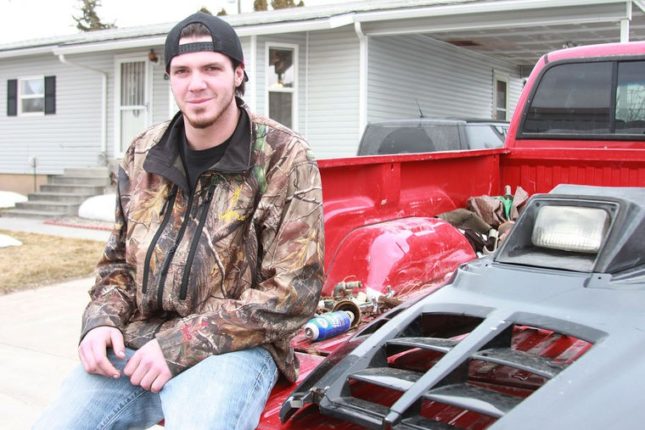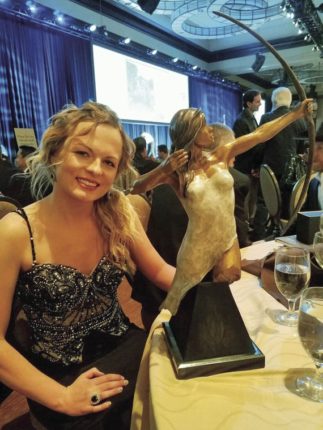PRESTON — As Kacey Hebdon sat in a makeshift snow cave underneath his incinerated snowmobile and his ears strained to hear the search-and-rescue sleds in the distance, a sinking feeling began creeping into his thoughts.
He started to wonder if he was going to make it out alive.
“I started losing hope,” he said. “I didn’t think they were actually going to find me. Hearing sleds all day and just knowing they’re out there looking and nobody can find me, I started to lose hope.”
Now, Hebdon, 20, is safe and sound back in Preston — with a few frostbitten toes the only reminders of his harrowing journey in East Idaho’s backcountry.
But after being separated from his snowmobile riding group in the Copenhagen Basin — which is located between Montpelier and Preston — Hebdon knew he was in trouble.
It was Sunday. Hebdon and his companions had set off for the trails — trails Hebdon had ridden several times before — in the morning. By the afternoon, however, a storm was setting in, and the group was working its way back toward the parking lot.
The wind was blowing, the snow was falling and visibility was poor. Hebdon directed his snowmobile over a hill across the trail, and before he knew it, he was disoriented.
And what was worse — he was by himself.
“I started thinking, ‘I’ve traveled way too far. I don’t remember any of this. I’ve gone way too far,’” Hebdon said. “And then I tried to backtrack and I ended up doing a circle for some reason. … At this point, I didn’t know where to really go.”
Hebdon got out his phone, dialed 911 and told the dispatcher that he was lost. He was told to stay put so search and rescue teams could pinpoint his location via his phone call.
He found a tree, dumped gasoline from his sled onto some collected firewood and lit a fire. As darkness fell, he heard snowmobiles. None were coming his way.
It was at that point Hebdon tried to set a tree on fire to signal to emergency responders. He leaned his snowmobile up against a tree and set it ablaze, but it didn’t work. By this time, it was around 1 a.m. Monday, and blizzard conditions forced the search to be put on hold.
Hebdon managed to dig a snowcave underneath his burned-up snowmobile. He crawled inside and fell asleep. With dropping temperatures, he did not know if he would awaken.
“Going to sleep, I’m thinking, ‘Am I going to wake up from this? Or am I going to get too cold while I’m asleep and not wake up?’” Hebdon said.
Hebdon, however, woke up many times, each time peeking out from under his coat to see if the sun had risen yet. He finally woke up for good around 8 a.m.
Though snow was still falling, Hebdon walked around his improvised campsite to get a handle on his surroundings.
Then, sometime in the afternoon, he heard more snowmobiles.
“I was like, ‘Oh those are getting close to me,’” Hebdon said. “‘I better run out there.’ So I ran out into the meadow. By then, they had already turned around and were going back the other way. I tried yelling, but I guess they didn’t hear me.”
Disheartened, Hebdon walked back to his shelter.
However, the three riders — Hebdon’s friends Justin Coleman, Buckey McKay and Dillion Drury — turned around again and continued making their way across the meadow, where they stumbled upon the footprints Hebdon had made when he tried to flag them down. Coleman, McKay and Drury followed the tracks and found Hebdon.
“I was so happy when I heard people, heard people yelling my name,” Hebdon said. “I was just like, ‘Oh my gosh, people are really here.’”
Hebdon tore off the only salvageable piece of equipment on his snowmobile — its hood — and jumped on the back of McKay’s sled. The foursome made their way back to the parking lot, where an ambulance — as well as Hebdon’s family — was waiting.
“It was just a relief that I was actually going home, that I actually made it out,” Hebdon said.
Hebdon was stranded in the backcountry for 27 hours. He always figured people who got lost were being careless, reckless or weren’t experienced. He never thought he’d be in a life-or-death situation and need to be rescued.
The lesson Hebdon gleans from that? Getting stranded can happen to anyone, so always be prepared.
“It’s so crazy how fast it actually happened,” he said. “Within two minutes of losing the group, I was lost.”


